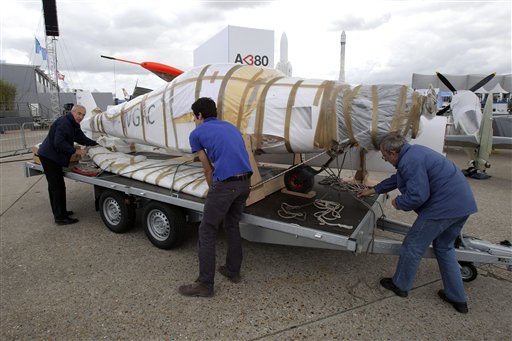A trio of plane makers was seen pushing a trailer with an aeronautical looking object into the Paris Air Show last week. It turned out to be the Greenelis PXLD, a Green Flight Challenge flyer, and it looked a great deal like the offspring of the Dieselis and the Gazaille, two French light sport aircraft powered by converted Diesel automobile engines and designed by Paul Lucas.

Bernard Stervinou, left, Arthur Nirma, center, and Paul Lucas unload their improved fuel economy plane Greenelis at the Paris Air Show in Le Bourget, east of Paris, Sunday, June 19, 2011. AP Photo/Michel Euler
Like its predecessors, it is made of wood and plywood, but in this case has a wing spar built of carbon fiber with “innovative geometry” and a wing covered with plywood. Greenelis’ fuselage has wooden formers and longerons, and like its forbearers, a plywood shell giving its aerodynamic form.
The 11 meter (35.2-foot) span, Two-place side by side craft is powered by an 800 cc Mercedes Smartcar turbocharged Diesel engine that produces 30 kilowatts, or 42 horsepower. A single retractable, center-line landing gear (with outriggers) helps give the 275-kilogram (605 pounds) empty-weight airplane a 220 kilometer per hour (136.4 mph) top speed and a 160 km/hr (99.2 mph) cruise. At that speed its petite engine sips a mere 1.8 liters per 100 kilometers (130.7 miles per gallon), or 261.4 passenger miles per gallon, well within one Green Flight Challenge criterion.
On static display for the week, showing off its F-WGFC registration, Greenelis shared the limelight with its larger and tinier green counterparts in exemplifying the quest for ultimate aeronautical efficiency.

Comments 4
Their website says the glide ratio is 20. Their competition weight must be at least 1015 pounds because CAFE says 200# per person. If they can go 136.4 mph on 42 BHP with a 90% prop they must have a V for L/Dmax = 69.6 (this assumes no laminar flow drag bucket). If you assume top speed is sea level and use 4000′ for the competition, their fuel consumption at a SFC of 0.35 would be 1.042 gallons per hour at 100 mph which is the absolute minimum for the contest. To make 200 MPPG they need under 1.0 gph at 100 mph. Their claim is much better than that. Details of calculations on request. In simple terms, the numbers don’t work as given.
(Editor’s note: I keep finding we have an enormous range of skilled readers. The team’s numbers do not seem out of line with their previous experience, so I may be guilty of printing their web site’s numbers without reflecting too deeply on them. I’d love to hear from the Greenelis designer.)
Pingback: Green Flight Challenge - Relevance and Goals - Page 10
It has been pointed out to me that the French word “finesse” can mean either glide ratio or aspect ratio. That required additional analysis. I posted a long look at it here: http://www.homebuiltairplanes.com/forums/hangar-flying/10487-green-flight-challenge-relevance-goals-4.html#post104850
The result remains that their numbers don’t seem to be possible without some revision.
(Editor’s note: Readers are encouraged to review Mr. Handelman’s analysis and spreadsheet, and submit their own calculations. I’d like to ask Mr. Handelman to review the perfomance of Dieselis and Mike Arnold’s AR5. Dieselis, also designed by Paul Lucas, had a hefty Opel engine and still managed excellent, but not GFC, fuel useage. AR5, I contend, could make GFC mileage requirements if it were slowed to the 100 mph average speed for the GFC 200 miles, even with its two-stroke Rotax. I think the overall review of the Greenelis is instructive, but doesn’t take into account airfoil selection, possible reflexing of wing flaps, ailerons, etc.)
A trio of plane makers was seen pushing a trailer with an aeronautical looking object into the Paris Air Show last week. It turned out to be the Greenelis PXLD, a Green Flight Challenge flyer, and it looked a great deal like the offspring of the Dieselis and the Gazaille, two French light sport aircraft powered by converted Diesel automobile engines and designed by Paul Lucas.
This is false,
I am originally from the idea of diesel I was associated [with] lucas just for design.
So is the Dieselis Pennec and lucas. And Lucas has nothing to do with gazaille.
(Editor’s note: Thank you M. Pennec, for the corrections. I regret these errors.)